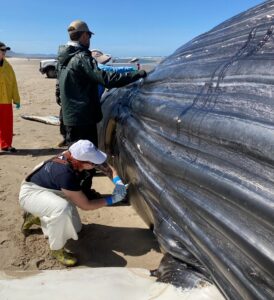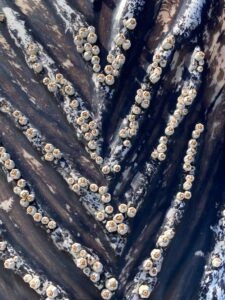
By MICHAEL MILSTEIN/NOAA Public Affairs
This is the story of a necropsy and the clues it revealed, one by one, about what ended the life of a young humpback whale. It died in May off the north Oregon coast.
A necropsy of a stranded whale provides a rare glimpse into the life of the animal, its species, and the marine ecosystem on which it depends. Autopsies on humans help divulge the cause of death and contributing factors. Similarly, a necropsy of a marine mammal helps researchers unravel what affected the animal in the final weeks and days of its life.
A necropsy of a large whale requires a team of trained responders authorized by NOAA Fisheries as part of the West Coast Marine Mammal Stranding Network.
The team on this particular day included biologists, graduate students, and a local teacher. They gathered around the bloated carcass of the young male humpback whale on the north Oregon coast. The carcass had drifted to shore a few days earlier, coming to rest upside down on a sandy beach. The grooves along the whale’s throat that had once unfolded like a balloon as it gulped great volumes of water and prey glinted in the sun.
Wisps of water vapor rose from the carcass as decomposition heated the roughly 15 to 20 tons of blubber, baleen, muscle, and internal organs. They would gradually unfold onto the surrounding beach over the next few hours. Like the vapors, the smell followed the breeze.
The carcass would soon tell a whale of a story.
Uncovering what’s inside
While one necropsy yields insight into one animal, necropsies together can reveal health trends and newly emerging risks to the species and the ocean. Humpback whales range across the world’s oceans, but they are mostly hidden from view and harder to study than species on land.
“Through necropsies and sample analyses, we can better understand the effects of things like climate change, disease, and human impacts on the health of marine mammals,” said Jessie Huggins, stranding coordinator at Cascadia Research Collective who frequently leads necropsies of whales stranded in Washington state. “With the information from more detailed examinations, we become better equipped to detect and respond to changing conditions and emerging diseases.”

The first step in a necropsy is an external exam, looking for signs such as rope marks or the rakes of killer whale teeth that may have contributed to the whale’s death. Then the team begins peeling away the skin and blubber, exposing flesh, sinew, and bone. Like slicing the skin off an apple, removing the skin and blubber help reveal anything out of place. It can reveal bruising, swelling, or abscesses that can indicate an injury or disease.
Necropsy leader Dalin D’Alessandro of Portland State University hands out small serrated utility knives to team members, who spread out along both sides of the whale. They use the knives to pierce the whale’s dark skin, the blades slicing through the blubber.
The West Coast Marine Mammal Stranding Network is an alliance of organizations authorized to respond to marine mammal strandings along individual stretches of the West Coast. It responds to upwards of 50 stranded whales on the West Coast every year. The day before the humpback whale washed ashore, local residents had reported the carcass floating beyond the surf to the south. NOAA Fisheries coordinators set the response in motion.
“The network is on the front lines,” said Kristin Wilkinson, NOAA Fisheries stranding coordinator in the Pacific Northwest. “These are dedicated groups with years of experience who are trained to gather evidence so we can learn as much from the animal as possible.”
With the whale upside down, the necropsy team begins high on the whale’s belly. Lined up next to each other alongside the whale, each member of the team cuts and peels away a width of skin and blubber. They unfurl like rolls of carpet to expose the whale’s insides.
“We want to look for signs of why and how the whale died,” says D’Alessandro. She conducted an initial external exam of the carcass the day it became stranded. After further coordination, she returned 3 days later with a team to perform the necropsy. “Necropsies provide us with a unique opportunity to better understand the lives of these majestic animals,” D’Alessandro emphasizes.
Hints of what happened

The carcass does not take long to yield clues. D’Alessandro studies marks on the tail flukes of the whale, where an entanglement in rope or fishing gear tends to leave marks. However, nothing in the skin here or on the rest of the carcass offers evidence of ropes rubbing for extended periods.
Then one of the team spots blood pooling near the animal’s mouth, a possible sign of trauma. Dark red tissue around the right side of the whale’s jaw shows that there is a substantial hemorrhage under the skin. The dark hemorrhagic tissue is obvious in contrast to the surrounding lighter colored tissue.
Usually, extensive bleeding, bruising, and swelling are signs of a blunt force impact, such as from the bow of a vessel. As more of the skin and blubber comes away, the darker red flesh of hemorrhagic tissue extends along the right side of the whale. Lesser areas of hemorrhage emerge elsewhere on the whale, a sign that the force of the impact spread over a wider area. Increasingly, the clues point to a possible vessel strike as the cause of death.
Vessel strikes are the second-most common cause of death of humpback whales off the West Coast. They follow only entanglement in fishing gear, according to NOAA Fisheries’ most recent stock assessment for the West Coast population. The data from necropsies contributes to the stock assessments, which inform the management and protection of whales.
Sampling the remains
One of the final steps is to collect samples of the animal’s vital organs. Several members of the team gather to search for the internal organs, which because of the whale’s orientation are hidden from view. They use the long-handled hooks to pull much of the jumbled conduit of intestines out of the carcass, providing access to the animal’s interior. Others pull back the exposed ribs. Then D’Alessandro climbs into the center of the carcass to search the animal’s insides.

She and the team slice off pieces of tissues, gathering both the hemorrhagic and normal flesh for comparison by a veterinary pathologist. Researchers may collect anywhere from a few to nearly 100 samples during a necropsy, depending on the condition of the carcass. In the case of the humpback, they collected about 30. The team hands D’Alessandro vials to collect samples of the stomach contents, and the urine and feces from inside the kidney and intestines.
“The organs can tell us about the health of the animal and show signs of disease that we may not see evidence of elsewhere in the whale,” she said.
While the necropsy proceeds with clinical efficiency, the team recognizes that the flesh and bones they are examining belonged to a living, breathing animal just days before.
What happens to whales after necropsies is usually up to the landowner. Sometimes tribes seek parts of whales for ceremonial and subsistence use. Some landowners bury carcasses to reduce their sight and smell. Managers of the Oregon state park where this humpback whale stranded decided to let it decompose naturally. With the likely help of scavengers, this process will redistribute nutrients into the coastal ecosystem.
“You do have to look at an animal one step at a time,” D’Alessandro says. “Hopefully, we can put those steps together to better understand the life and death of this whale.”
- Michael Milstein covered the environment and science for almost a decade at The Oregonian newspaper before joining NOAA Fisheries as public affairs officer for the West Coast Region, Northwest Fisheries Science Center, and Southwest Fisheries Science Center. He can be reached at Michael.Milstein@NOAA.gov
For more information
West Coast Marine Mammal Stranding Network
Frequent Questions: Necropsies
National Marine Mammal Stranding Response Network
Marine Mammal Health and Stranding Response Program




Can you explain what is being done to slow down vessels and prevent strikes?
I know there’s speed limits in much of the surrounding ocean in the US and ships are known to not obey them. They need to be doing more to counter this. Its getting ridiculous and people are either ignorant or they don’t care. https://oceana.org/press-releases/oceana-finds-most-boats-speeding-in-slow-zones-designed-to-protect-critically-endangered-north-atlantic-right-whales/
If vessel strikes are such a contributing factor in C.O.D. of many whales and other marine life are steps being taken to mitigate the effects of or entirely prevent these strikes from happening?
I agree with every comment read so far. What can we do to stop the whales from being struck? I am willing to volunteer my time and help to whatever it is I can do to help stop this from happening again.
Tragic end. Can ships be equipped with sound warnings that triangulate the heading and perhaps the speed of the ship? I’m certain that if the damage done was to the ship rather than the whale a fix would be found.
Great read. Thanks for the insight. Sadly, many vessel operators are only focused on their mission. Not following the rules or preventing such things from happening. I’m sure we will come up with an innovative solution to slow down and eventually prevent this from happening in the future.